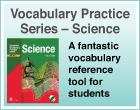Egbert Weisheit reviews the first in Macmillan's Vocabulary Practice series which focuses on the content vocabulary of secondary science topics.
 |
This book and CD ROM seems to take a simple didactical approach but in fact offers very thorough coverage of the language and content of secondary science. After all, using words alone is not enough to describe, for example: the structure and function of living beings in Biology; certain chemical substances and their reactions in Chemistry; or the rich variety of Physics. Students need to make use of all the 'instruments' that they are taught in language lessons to form full sentences or well thought-out arguments in their science lessons. This book covers both the content vocabulary and the language needed to communicate it.
Teaching Science in a Second Language
For the Science teacher, Keith Kelly’s book provides a range of 28 key science topics from Living organisms to the Solar system combining basic science and a range of linguistic tools that students develop in their language lessons. It’s an introduction for science teachers to make use of their students’ language competencies.
- Word lists with definitions and example sentences. Students can write translations and their own example sentences;
- Practising words in activities like: mind-mapping, labelling, filling in gaps, filling in grids, completing sentences.
Teaching a Second Language using Science Topics
For the language teacher, this book mobilizes a teacher’s knowledge of science from his/her schooldays and is a motivating source for preparing students to read and communicate about science.
Combining paper based learning and CD-activities
The book can be bought with a CD ROM which can be used in class or at home. The key features are:
- Word Search provides a searchable list of all the words and gives the definition and pronunciation of the word;
- Activities give access to a range of possibilities from “fill in” words. Words can be freely chosen, chosen from a drop-down menu, drag and drop, multiple choice and check, matching sentences, completing crossword, word dictation, match words with definitions;
- Recordings are included in many activities and help students working with sentences or diagrams and simulate the learning situation during a lecture. This is a very nice feature.
- Word map raises a tool easy to work with to create your own word map. Students may compare their specific products and easily enter communication about the topic and their understanding.
- Diagrams may be shown with labels or just with numbers to initiate communication or to further challenge the learners. They are “clickable” to enlarge them and there are two tools, a pencil and an eraser to add specific notes. These are nice things but they are not easy to work with. Handwritten notes with the mouse are rather tricky and the eraser only works if you click on the written note to delete it. I think it would be better to have a third tool, adding notes with the keyboard and with the eraser working like an eraser.
- Animations work step by step and you many add notes with the pencil and remove them with the eraser.
Last but not least, there is an Answer Key to help teachers starting out with CLIL-activities. There are four versions of the book (without key, with key, without key/with CD-ROM and the final one: with key and CD-ROM), so you can choose an appropriate issue for your and your students’ needs.
The book leads from 'just reading and writing' to real communication with structured sentences, using structures and functions of science subjects. I like the material as it helps working with a student-centred pedagogical approach which is a big issue in discussions among teachers today.

No comments yet